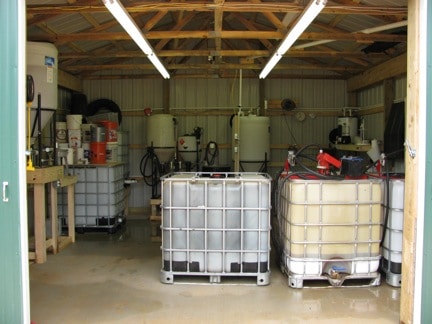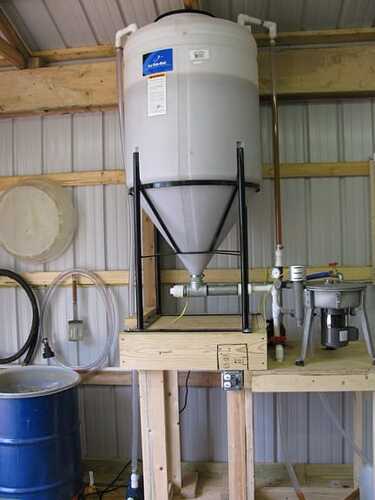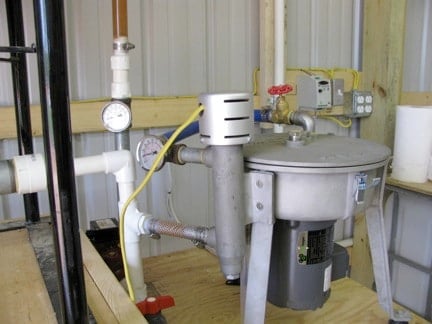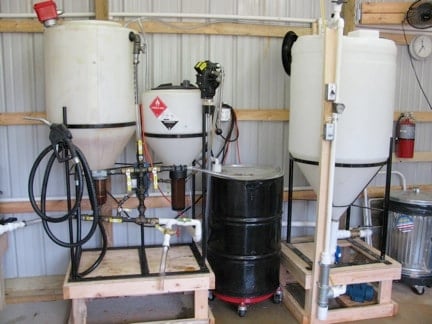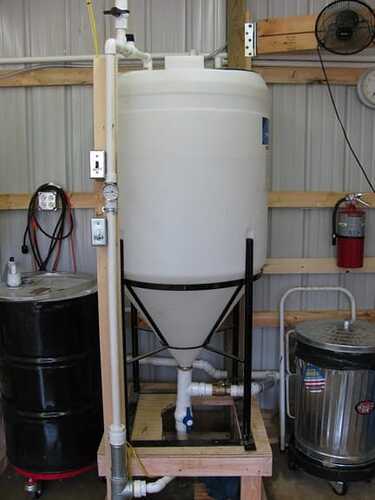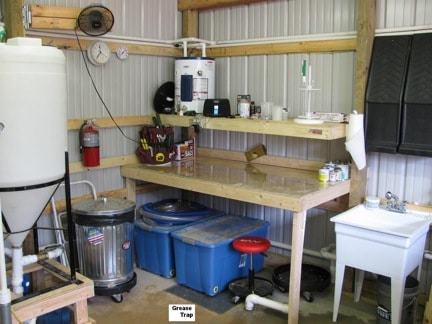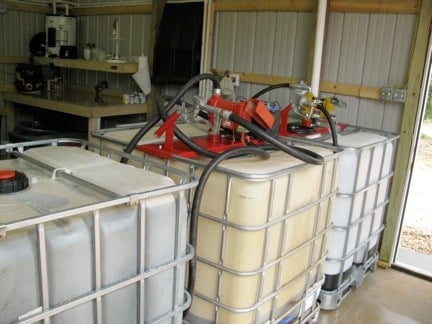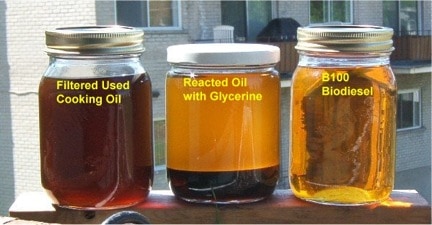You might say that I am a bit of an unconventional thinker. I generally take a different approach to things than what most people do, given the same stimulus. I believe I am in good company in that regard here at PeakProsperity.com. I clearly understand the controversy over employing biofuels as one method to prepare for the coming storm. Let me say right up front that I do not believe biofuels will allow our existing civilization to sustain its current high net energy lifestyle by substituting biofuels for oil. My argument for the application of biofuels is at a much more personal/community level. I have been asked repeatedly about what and why I am doing this, so I am posting this as a service to the PeakProsperity.com members who have questions that may not have been answered yet.
It was in 2006 that I first learned of Peak Oil. That topic is what eventually lead me to Dr. Martenson, who put things in a broader perspective for me. However, as the Three E’s go, it is clear that Energy has been my primary play, since it is what started me down my current path. At first, I must admit that I poured myself into understanding our energy predicament out of fear. Gratefully that has long since passed and I now have a tremendously satisfying hobby that actually produces wealth rather that consumes it. Although I have not always felt this way, I now view stored net energy as wealth the same way most people look at a bank account. What a comfort it is to be partially insulated from the whims of OPEC and my perceived inevitability of Peak Oil.
In early 2007, I devised my plan. Gasoline cost was rising, and I knew I could not stand idly by. Being an action-oriented person, I traded my gasoline-based truck for a diesel, and began my learning curve. First step: biodiesel.
With a little help from the Internet, a local biofuels club, and a lot of late nights tinkering, I began producing biodiesel (BioD) in my garage. Small amounts at first as I learned the techniques that produced the best fuel with the least waste. As I learned, I improved my processes, and was able to produce 100% of my truck’s fuel requirements within a year. As someone who drives quite a bit for work and other reasons, this was a major triumph. At $4/gal average for petro diesel at the time, I was able to contribute over $8,000 a year in savings to my personal budget. I approached this as a business would, using its profits, and re-investing those savings back into improving and expanding systems, oil sourcing, and knowledge. Here is the culmination of nearly 5 years of dedication to my hobby:
We affectionately call this the Meth Lab (for methanol… what were you thinking?)
Overview of 20’ x 20’ x 10’ custom made barn
Filtration and de-watering Setup
Centrifuge
Biodiesel conversion setup
Wash and Dry tank
Bench, Grease trap, Hot H2O, etc
Finished product storage / delivery tanks
And here is a video that helps to put it all together and explain how it works:
http://www.youtube.com/watch?v=D-ZymOoOzZA
While this post is not meant to be a full on tutorial of biodiesel production, I have provided the framework below. What I would like to address is a bit more important, namely what it could mean to your family and community. What if we wanted to ramp up personal biofuels production and see where it takes us? Where does it start and stop making sense?
I have a small hobby farm in a very remote community (where the above pictures were taken). It is very tightly knit, and people have been living with less than those in the big cities for, well forever. When you factor in rising fuel prices in a small farming community like this one, it makes life that much more of a struggle. There is a large Amish community, and I can say from personal experience that even they become impacted as fuel costs increase. I don’t see how anyone can escape it, but I believe changes can be implemented to minimize impacts. There have been some great posts in this series on issues like electricity generation and weatherizing your home, but the focus here is liquid fuels to build on what you may have already done in other parts of your preparations.
I have been dabbling in growing and pressing canola on my small farm. In general, you will harvest slightly more than 100 gallons of oil per acre planted. That far surpasses the typical commercial BioD feedstock of soybeans, and the pressed cake can be used as feed for livestock (in the chart in the link, canola is listed as rapeseed). Anyone with chickens, goats, pigs or cows would love to get their hands on pressed oilseed cake.
With some success under my belt, I have gone out to local farmers and garnered interest in working together to use their skills, tools, and land to increase the oilseed production in our community. It is my goal to perform the communities pressing and processing needs, while charging only a small portion of the pressed oil in exchange for the services rendered. Currently, land is very cheap here, and much of it goes unused, or is fenced in thousands of acres at a time and used for grazing cattle or other animals. There is an abundance of tillable acreage that goes either unused or underused.
With the ability to produce as much fuel as is needed for a farmer on his/her farm, it is very hard to calculate EROEI. One school of thought would say that it is very high, since you are producing oil where there was none. Another would say you need to factor in things like the energy embodied in the tractor, the farmer’s house, the food he eats, etc. How much of the tractor and food to you attribute to oil production since he already had the tractor and was sure going to eat anyhow? I don’t have a specific quarrel with either method, but I can say with no hesitation that small scale has the potential to be greater than the 3.2:1 often quoted for (soy based) commercial BioD production. It would be my contention that EROEI of 3:1 cannot support the energy intense lifestyle we currently enjoy, even if there was enough land and resources to produce it for all without impacting food production. We need a higher EROEI or there is a highly diminished argument to pursuing biofuels.
The other key that I have not mentioned yet is that it is a self-sustaining process. Between the diesel tractors used to plant and harvest, the diesel engine used to power the press, the diesel generator used as a backup to the solar and wind power in place, and the ability to burn the waste glycerol as an input to the system, once you are running you produce far more energy than you consume in the production. I’ll take a very conservative, back of the envelope stab at putting some of this into perspective:
- 10 acres planted
- 1,200 gallons of oil produced
- Tractors require 20 gallons for 10 acres production
- Diesel genset requires 5 gallons for electricity input
- 10 gallons used to press oil
- 5 gallons used to process hardwoods for outdoor boiler
Total produced: 1,200 gallons
Total used: 40 gallons
EROEI: 1200:40 = 30:1
Now, I have handily forgotten a few inputs:
- Methanol
- Lye
- Water
- Fertilizer
- Seed
- Tractor Maintenance
- Transportation
- Opportunity cost of land
- Infrastructure for containment and delivery
- Time invested
- System maintenance
- Misc
So clearly we are not at 30:1, but I do not have the data to accurately calculate what the actual number is. Things like seed are a first year problem only, as a portion of the harvest is kept to sow next year. Fertilizer is not a large expenditure due to the nature of the area with the vast quantities of manure available and the fact that canola does not destroy the soil nutrients like corn or some other plants do, and the same plot can easily be rotated with a complementary summer crop to get 2 harvests out each year. Pressed cake can be fed to livestock and the resulting nutrients re-applied to the soil. Natural Gas is the primary feedstock in fertilizer and methanol, further complicating the calculation. Methanol and Lye can be drastically reduced by using straight vegetable oil (SVO) vs. conversion to BioD. Most of the infrastructure is a one time purchase, and can be easily amortized off in the first year by petroleum fuel savings. Cost of land will vary widely based on location, but in my case approaches zero.
So where does this leave us? With the ability to produce our own fuel at an undetermined EROEI. Is it worth it? That is for you to decide given your personal circumstances. I think it is clear by now what I have decided. If ever there was an appropriate place for YMMV, this is it.
I view biofuels in the same light as weapons and PMs. They are not for everyone. They can be used as a tool to attempt to extract a desired outcome. It only takes a theft or a home invasion for some folks who previously would never consider gun ownership to begin to change their mind. For the folks who do not consider biofuels as a positive now, it is my hope I have convinced you that there is an alternative to going without when we happen upon our next oil shock. Unfortunately, if you wait until the next shock to get started, you will be a bit late to the party.
SVO vs. BioD
Above I mentioned SVO as an alternative to BioD. As my experience has increased, I have been converting systems over to SVO to minimize energy and chemical inputs into my process. Here’s how it works in a diesel vehicle:
- Start and stop your engine on BioD or petro diesel
- Once the engine is up to operating temp, use the waste heat from the engine to pre-heat the SVO
- Shut off the primary fuel input to the engine and replace it with heated SVO
- When the vehicle is going to be shut down, purge SVO out of the fuel system to prevent gelling
- Put BioD or petro diesel back in all the fuel system and lines for next start up
The issue of using SVO relates to the fact that viscosity is so much lower than diesel, and only obtains the correct viscosity to be pumped and sprayed through injectors once it reaches 140*F – 160*F. Think about pumping Wesson Oil or butter into your tank as opposed to petro diesel. Now think about how well that same butter runs around your frying pan once heated. Luckily, I’m not the first person to attempt this, and there are kits on the market that add the necessary heating loops, valves, and automation so that once installed, you can essentially forget about them and your vehicle will take care of running the appropriate fuel at the appropriate time. After spending some time analyzing options, it prompted me to make a vehicle change and incorporate a VegiStroke conversion kit from BioFuels Technologies. I was so pleased with this system that I further replaced my wife’s vehicle so we could both run SVO/WVO directly. The end result is that I get well over 100 miles to the gallon of BioD added to the main tank since once up to temp, you stop using BioD. Depending on your climate, petro diesel can be completely eliminated or only used in the coldest of weather depending on the gel point of your BioD and ambient temps.
SVO can come from feedstock you grow, or from the WVO you collect from restaurants or purchase from a renderer. I use a heated centrifuge setup to spin the oil at 6000 G forces filtering it down well below a micron, and eliminating water at the same time. No consumable filters are needed. Once centrifuged, it can be pumped directly into the vehicle. Again, these systems have been paid for many times over in savings at the pump. I am unable to accurately calculate EROEI of SVO, but I can feel it in my wallet without a doubt. If crude oil gets to some of the prices I have recently heard batted around, while the costs of goods that rely on oil may go up, the price at the pump will have little effect on my personal finances.
While I heat with wood, I know of several other people who use WVO/SVO as the heat source in their homes and shops.
Ethanol
I don’t have much to say on the topic of ethanol. While I do have some experience, it is not, in my circumstances, a viable alternative fuel. While it can be used in BioD production in place of methanol, and therefore may play a small role in my future, I find that the hands on time to produce, the energy and feedstock inputs (lower EROEI), the fact that it is highly flammable and hygroscopic (making it difficult to store in large quantities), the risk vs. reward for operating a moonshine still, and a few other factors make it a less desirable liquid fuel in my case. I know others that do use it with some success.
Algae Diesel
Currently a work in progress, algae does present the distant possibility of producing economical feedstock for BioD. The US military is pushing this R&D and have proven its ability to power a ship and planes can fly on algae power. Currently, the costs to produce a gallon of algae based BioD are so high it is not even a contender in the biofuels arena. I am watching this one closely because it has potential, and who knows what the military has discovered that we have not been informed of yet!
Hydrogen
Hydrogen is not a fuel source, it is a storage platform akin to a battery. Its EROEI is below 1.
Methanol
There is much ado in certain circles about the potential for a methanol economy. While I have no particular axe to grind, I think this is in the same class as hydrogen. Methanol is primarily manufactured from Natural Gas, although there are several ways to get there being the most simple alcohol. Again, it takes on the form of a battery rather than a fuel source, a battery that uses fossil fuels for creation.
An Overview of BioD production at the small scale
Collection
Every biofuel needs a feedstock. This is the basic rub as to why biofuels are controversial. If you take productive land out of use to produce fuel rather than food, controversy is a given. In my case, this started as waste vegetable oil (WVO) from local restaurants, which does not seem controversial to me on the surface. I started with a Chinese joint and a bar and grill that was known for chicken wings. I then added on from there, and before long was collecting more than I needed for personal consumption. So, depending on your point of view, I was converting a waste product into a 1:1 replacement for petroleum. Add to that that I employ ground that was previously unused for anything as land to convert sunlight into oilseed, and I feel I can sidestep most of the controversy personally.
I had a good relationship with my restaurants, and I was not charged for this oil. It was a win-win, and I made sure to treat them well and frequent their dining rooms. This is not as easy today as it was then because of the $1/gallon biodiesel tax incentive H.R 4853 signed by Obama in December 2010, increasing the value of yellow grease on the rendering market overnight to near that of a gallon of diesel! It is still very possible to collect, but if you are just starting out, be prepared to pay a little for the oil you collect.
Transesterification (Warning – Science Content)
When we make BioD from an oil feedstock, we are starting with a triglyceride (3 acid chains bonded to an alcohol, in this case 3 fatty acids bonded to a glycerin). While the actual triglyceride may be different depending on the oil feedstock you use, the process is essentially the same. This is the way I like to picture it:
Hold up your hand with 3 fingers extended. This is the triglyceride molecule. Your fingers are the acid chains, and your palm is the glycerin. Our goal is to cut off the fingers and bond them with another alcohol, each of which would become one molecule of BioD. In our case, we use a catalyst called lye (Sodium Hydroxide (NAOH) or Potassium Hydroxide (KOH) ) to do the separation, and a donor molecule of methanol takes the place of the glycerin. When the process is complete, the glycerin is separated from all of the fatty acid chains, which results in BioD and glycerin as a byproduct. While this is a bit of an oversimplification because not all feedstocks are created equal (for example, a well used cooking oil will have begun to break down and create Free Fatty Acid (FFA) chains that are floating around, not connected to any glycerin molecule, or they may be connected with a single bond i.e. monounsaturated vs multiple in polyunsaturated or fully saturated) it does not materially effect the process you use to make the BioD. It only effects the amounts of catalyst required to create the complete reaction. No matter what the feedstock is, you will end up with a hydrocarbon you can use in a compression engine directly.
So, how do we manage all these different potential feedstocks? The simple answer is we adjust our catalyst amounts based on measurements called titration.
Titration
SAFETY WARNING: Before attempting to work with any chemicals, please watch this safety video.
http://www.youtube.com/watch?v=IFKUUhYWlbo&feature=player_embedded
Titration is a test performed on a feedstock to determine the amount of base (KOH or NAOH) is necessary to neutralize any FFAs in the feedstock. It is essentially a method for determining how to create a neutral PH in the feedstock. It involves using a specific amount of feedstock, a measured amount of isopropyl alcohol, a PH indicator like Phenol Red or tumeric, and a prepared solution containing a known quantity of the catalyst you will use for the process. The solution is carefully added to the sample until the color changes to alert you to a neutral PH. A calculation is then performed to determine the total amount of catalyst needed for the amount of feedstock you will be processing. That’s all the brainwork necessary; the chemicals do all the heavy lifting from there.
<a< p="> </a<></p> <h2>Mix Chemicals</h2> <p>Now that you know how much catalyst you need, we need to get the system prepared. First, we measure out the correct amount of methanol, in my case 8 gallons because I process 40 gallons of oil at a time, and SLOWLY stir in the catalyst. This will create an exothermic reaction as you create methoxide from the 2 chemicals, so care must be taken to add in the lye slowly.</p> <h2>Prepare the oil</h2> <p>During all of your chemical preparations, the oil was added to the reaction vessel and being heated. In my setup, all water and contaminants to below 1 micron have previously been removed. We need only to heat the oil to 140*F.</p> <h2>React</h2> <p>Once the oil is at temp and the methoxide is ready, it is slowly added into the reaction chamber and stirred for about an hour. The pump is then turned off, and the mixture is allowed to react, and then settle into its 2 phases, BioD at the top, and glycerol at the bottom. This is made clear in the middle jar below.</p> <p style=" text-align: center>
Separate
After the phase separation is complete, the glycerol is easily removed from the bottom of the tank and saved for pre-processing on the next batch. What remains is BioD contaminated with small amounts of methanol, lye, and soap. This is the cloudy yellow top layer in the picture above. The glycerol is the dark substance at the bottom.
Wash and Dry
The BioD is then pumped into the wash / dry tank for processing. I do 2 - 3 40 gallon batches at a time in the wash tank, so the next batch of oil is pumped into the reaction chamber at this time, another titration, and the process is repeated.
Once my wash tank is full, the BioD needs to be processed to strip out any remaining contaminants and soap. That is performed first by adding a mist of water to the BioD, and allowing it to slowly pass through to the bottom, collecting water soluble contaminants along the way.
An aquarium bubbler is then added, and the slight bubbling aids in further washing the BioD by lifting the water gently back to the top and dropping it thru again for another pass. You must be careful not to over-agitate at this point, or you will make soap.
After the BioD is completely washed of contaminants, the drying head is engaged along with the fan and heat, and water is driven out of the finished product. Once completely dried, the BioD is ready to be pumped into the tank.
If you want to know more details, you could do much worse than spending some time on Graydon Blair’s site, Utahbiodieselsupply.com. Here is a link to a group of video tutorials that will help you make sense of all of this.
Additionally, you may remember Graydon from a 2 Beers with Steve podcast where he talks about his entry into BioD and what it meant to him.
While I have no personal or financial connections to the companies introduced in this post, I do endorse them as a great place to start should you be interested in the gas station free lifestyle.
- Ready
This is a companion discussion topic for the original entry at https://peakprosperity.com/the-case-for-small-scale-biofuels/
